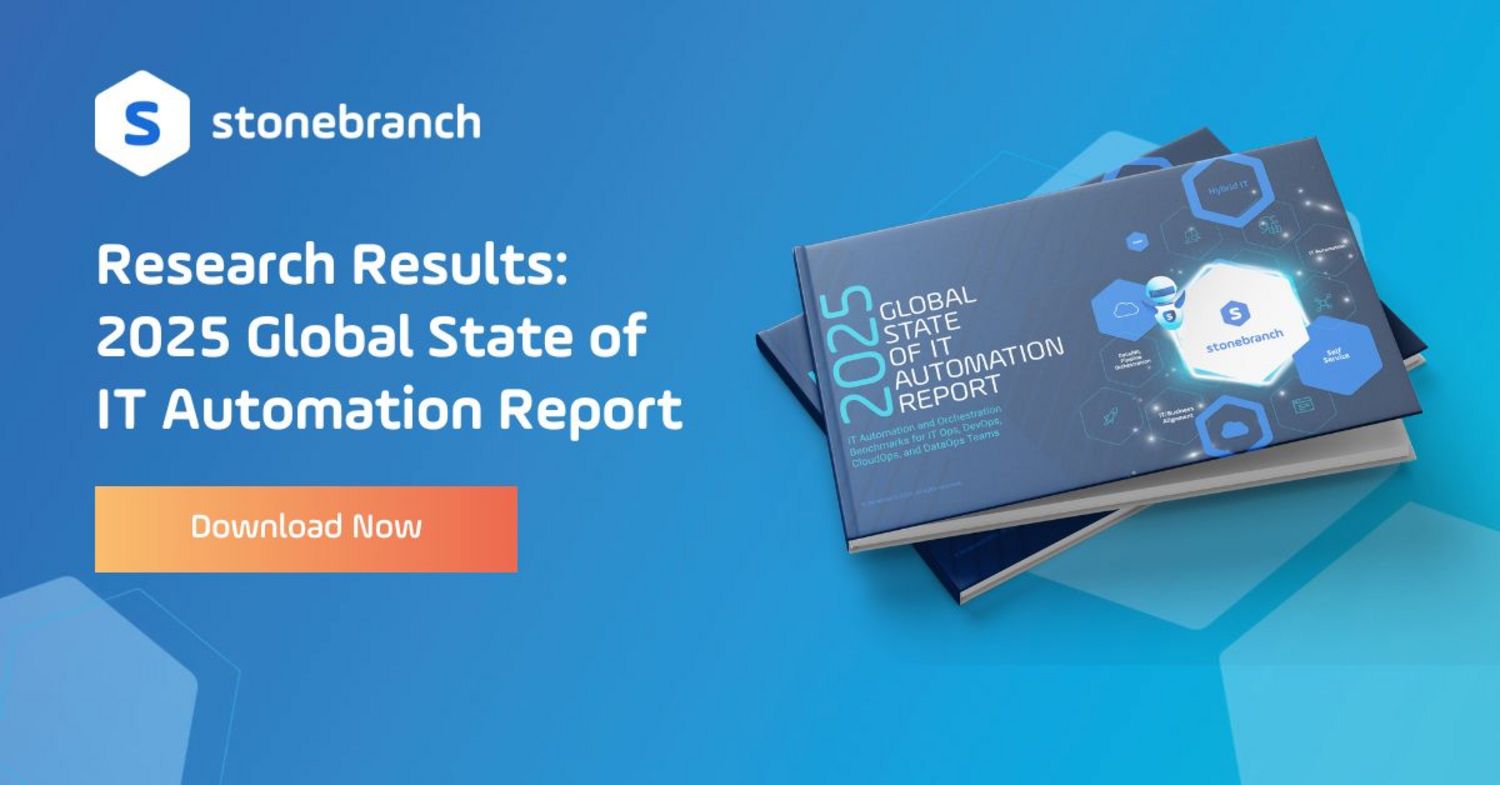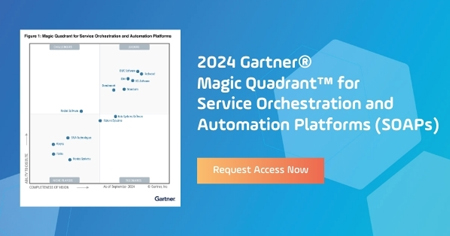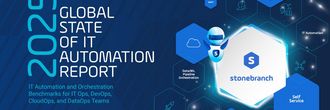What is Data Center Automation?
Explore how to automate the data center, including its traditional four-wall setup and its evolved ecosystem of physical, virtualized, and public cloud-based systems.

Data Center Automation goes back to the early days of the mainframe. Over the years, technologies have changed inside and outside the data center. As a result, tools and approaches have evolved as well.
This article discusses how IT teams use automation to manage data center processes. Additionally, we'll cover how IT teams automate on-premises alongside cloud infrastructure to orchestrate hybrid IT environments.
What is Data Center Automation?
Data centers provide an environment for managing the enterprise’s applications and infrastructure. However, configuring, provisioning, monitoring, and managing the systems can be manual and time-consuming. That's where automation is leveraged to increase efficiency, workflow, and agility.
Definition: Data center automation is the use of software to automate tasks in a data center. This can include provisioning and de-provisioning servers, configuring network devices, and monitoring systems. Reducing human interaction can help to improve efficiency, reduce costs, and improve uptime.
As an example, tasks or jobs commonly automated include:
- Provisioning and deploying virtualized workloads
- Configuration management of servers
- Patching or updating operating systems
- Moving data between applications
- Application deployment
How Have Things Changed?
Today, one cannot discuss the data center without acknowledging the cloud. In fact, according to the 2024 Global State of IT Automation, almost all mid-sized and large enterprise organizations are using both on-premises and cloud-based infrastructure. Additionally, they are most often using multi-cloud models. The industry refers to this overall strategy as a hybrid IT environment.
Private cloud technology has enabled enterprises to leverage the benefits of virtualizing their physical infrastructure. Meanwhile, public cloud technology has allowed IT teams to quickly scale with consumption-based access to compute, storage, and cloud-native applications. Using private clouds with public clouds is known as a hybrid cloud, which is a subset of a hybrid IT environment.
"Most organizations exist somewhere within a hybrid cloud model, in between the legacy on-premises data center and public cloud extremes," notes Gartner in the How to Evolve Your Physical Data Center to a Modern Operating Model.
Another way of looking at the equation is that the data center is not limited to a physical environment. According to the same Gartner report, "Data center functions are no longer centralized in a physical location, but rather deployed to meet complex business requirements by utilizing cloud, data center, colocation, and edge deployment locations."

Automating The Modern Data Center
The fractured nature of the IT automation application market makes it difficult to know where and what can be run without human intervention. Fortunately, to adapt to hybrid IT environments, some software vendors have evolved their capabilities. Generally, there are three approaches:
- Traditional on-premises-focused applications that cannot reach the cloud
- Cloud schedulers focused on cloud-only automation
- Automation and orchestration platforms that centralize the management of both on-premises and cloud workloads
Some IT departments are testing emerging cloud-native schedulers while maintaining legacy automation technology. However, there are limitations to this approach. The most glaring issue is that it creates silos of automation. As such, companies have shifted their approach to vendors and solutions that can centrally manage all workloads, regardless of their physical location.
What are the Most Common Automation Categories?
There are several different application categories to consider when automating the data center.
Below is a list of the most common categories, along with representative software provider examples.
- Infrastructure Automation: Helps provision and de-provision virtual machines across on-premises and cloud. Operations teams typically use a mix of the below applications to configure credentials, create databases, and even install applications.
Representative Solutions: Terraform, Chef, Puppet, and Ansible - Service Orchestration and Automation Platforms (SOAP): As an evolution from traditional on-premises-focused job scheduling applications, SOAPs combine workflow orchestration, workload automation, and resource provisioning across an organization’s hybrid IT environment. SOAPs are central to an organization’s ability to deploy workloads and optimize deployments as a part of cost and availability initiatives.
Representative Solutions: Stonebranch Universal Automation Center - Network automation and management: Solutions that typically interact with routers, switches, firewalls, application delivery controllers, service provider components (WAN circuits), and cloud provider services (VPCs and load balancers, for example). This solution category allows organizations to reduce network outages and downtime by making network changes across hundreds, thousands, or more devices in short periods.
Representative Solutions: Juniper, Python (Scripts), Microfocus, Cisco Prime - Remote Monitoring and Management: A class of tools that discover & manage devices, monitor for problems, and take automated action.
Representative Solutions: Connectwise Automate, DataDog, 24x7, SolarWinds - Data Center Infrastructure Management (DCIM): A class of applications that monitor equipment utilization, energy consumption, air conditioners, and facility infrastructure components.
Representative Tools: Ansys Fluent, Nlyte, StruxureWare
Benefits
Data center management is greatly improved by replacing manual procedures with repeatable automation. In general, the best practice is to balance efficiency and agility by minimizing the time and effort required for repetitive tasks.
Additional benefits include:
- Free up time for IT staff to perform other functions
- Reduces potential human error and increases productivity
- Quickly provision systems and applications while meeting compliance standards
- Enhances collaboration between departments with self-service management tools
- Accelerate the resolution of issues impacting business processes
- Rapid response time to requests, reducing delays in critical operations
- Observability, via real-time monitoring, provides a unified view of all systems and applications
- Gain remediation capabilities in the event of system outages or other failures
Existing Challenges
While automation offers many benefits for the enterprise, several challenges exist. These challenges include:
- Managing hybrid IT environments that are designed to operate both on-premises as well as in the cloud
- Limitation of legacy automation platforms that are designed for on-premises systems only
- The cost and maintenance of your toolset
- The need for a skilled workforce to operate both older and newer systems
- Ensuring security, governance, and compliance
What Does the Future Hold?
Many organizations have adopted a "cloud-first" strategy. By design, cloud-first implies modernizing an IT environment by shifting all infrastructure and applications to the cloud. The obvious question this strategy invokes is: Will the traditional on-premises data center eventually disappear?
Most experts agree that physical locations are not disappearing soon. According to CIO.com, "a majority of enterprises haven’t moved entirely to a cloud-first approach." The reality is that even for the most diligent of companies, cloud-first takes time. And some legacy applications will never be transitioned to the cloud because they are more cost-efficient or secure to run on-premises.
All that said, the cloud will continue to replace on-premises technology. What the actual split between on-premises and cloud becomes over time remains to be seen.
Summary
Automation is a critical enabler for enterprises that want to improve operational efficiency, ensure compliance, and effectively manage workloads. Choosing the right platform and vendor is vital to achieving success. Learn more by checking out the major highlights from this year's Global State of IT Automation report webcast.
Frequently Asked Questions: Data Center Automation
What is the role of APIs and agents?
APIs (application programming interfaces) enable integration between data center systems and automation software. This mechanism enables workflows to be triggered based on events from external systems.
In cases where you have legacy tech without an API, look for agent-based connectors. Agents are little code bits installed on older systems, like the mainframe. They serve the same function as APIs, allowing your older systems to communicate with your automation applications.
What is the difference between physical and virtual data center automation?
Physical involves managing hardware components such as servers, storage devices, and network switches. Virtual involves managing virtual resources such as virtual machines, containers, and cloud instances. End-to-end orchestration involves managing both physical and virtual resources in a unified way.
What does intelligent automation do in the data center?
Intelligent automation uses machine learning and artificial intelligence (AI) to make decisions and solve problems without human intervention. This can help IT teams identify and resolve issues more quickly and improve the overall efficiency of operations.
What is the role of DevOps?
DevOps is a culture and set of practices that emphasize collaboration and integration between developer and operations teams. DevOps can help to streamline processes and create more efficient workflows for managing and deploying applications.
Start Your Automation Initiative Now
Schedule a Live Demo with a Stonebranch Solution Expert






